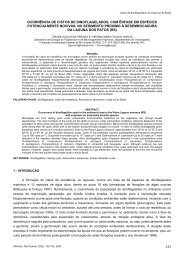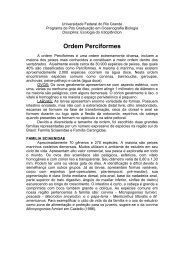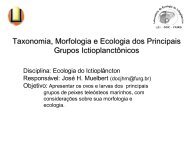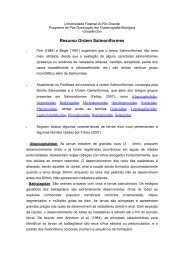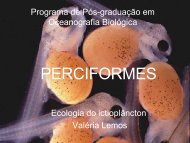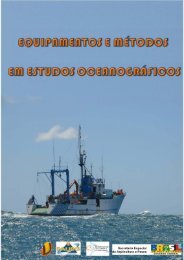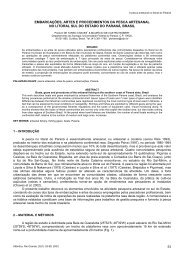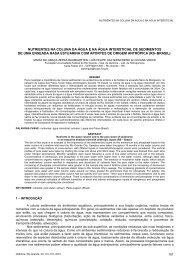- Page 2 and 3:
Informe sobre asEspécies Exóticas
- Page 4 and 5:
Ministério do Meio AmbienteInforme
- Page 6:
Ín d i c ePr e f á c i o.........
- Page 9 and 10:
sobre a rica biodiversidade da regi
- Page 11 and 12:
Foto: www.sxc.hu10Informe sobre as
- Page 13 and 14:
A zona costeira brasileira possui8.
- Page 15 and 16:
• Causar significativas perdaseco
- Page 18 and 19:
Ambiente Marinho 17
- Page 20 and 21:
Ca p í t u lo 2 - Mé to d o sRu b
- Page 22 and 23:
Devido aos processos dinâmicos dee
- Page 24 and 25:
Dentre esta multiplicidade de vetor
- Page 26 and 27:
que envolvem interesses econômicos
- Page 28 and 29:
Da d o s s o b r e a e s t r u t u
- Page 30 and 31:
Ambiente Marinho 29
- Page 32 and 33:
Ca p í t u lo 3 - Estat í st i c
- Page 34 and 35:
Tabela 3.4 (Continuação): Listage
- Page 36:
O incremento das pesquisas científ
- Page 39 and 40:
Foto: José Eduardo Martinelli Filh
- Page 41 and 42:
dinâmica que rege as interações
- Page 43 and 44:
exótica, mesmo encontrando condiç
- Page 45 and 46:
Tabela 4.2: Situação populacional
- Page 47 and 48: 46Informe sobre as Espécies Exóti
- Page 49 and 50: Histórico d a i n t r o d u ç ã
- Page 51 and 52: Me i o s d e d i s p e r s ã o - p
- Page 53 and 54: DINOFLAGELLATAAl e x a n d r i u m
- Page 55 and 56: Descrição do cisto em microscopia
- Page 57 and 58: ainda não relatado no Brasil. Entr
- Page 59 and 60: Ca r a c t e r í s t i c a s m o r
- Page 61 and 62: Im p a c t o sEc o l ó g i c o sH
- Page 63 and 64: Antena: artículos do exópodo 4, c
- Page 65 and 66: Distribuição g e o g r á f i c a
- Page 67 and 68: Ca r a c t e r í s t i c a s m o r
- Page 69 and 70: Sociais e c u l t u r a i sDesconhe
- Page 71 and 72: Lu g a r d e o r i g e mIndetermina
- Page 73 and 74: do que 700 µm de 0,011 mg C m -3 d
- Page 75 and 76: Im p a c t o sEc o l ó g i c o sDi
- Page 77 and 78: Lu g a r d e o r i g e mOceano Pac
- Page 79 and 80: Pr e v e n ç ã oEm â m b i t o m
- Page 81 and 82: confluentes com o somito, uma cerda
- Page 83 and 84: Co n t r o l eMe c â n i c o: Desc
- Page 85 and 86: Lu g a r d e o r i g e mIlha Mukais
- Page 87 and 88: Co n t r o l eMe c â n i c o: Desc
- Page 89 and 90: e os dinoflagelados Scrippsiella sp
- Page 91 and 92: de duas outras espécies são, na v
- Page 93 and 94: apical muito pequeno; na região la
- Page 95 and 96: ealizados em Sepetiba, RJ (Rodrigue
- Page 97: Ara, K. Temporal variability and pr
- Page 101 and 102: Marazzo, A. Record of Pleopis schma
- Page 103 and 104: Pereira, M.S. Distribuição do cop
- Page 105 and 106: STERZA, J.M.; FERNANDES, L.L.Zoopla
- Page 107 and 108: Foto: Leila Hayashi106Informe sobre
- Page 109 and 110: luz, pela temperatura, em escala gl
- Page 111 and 112: Tabela 5.3: Região de origem das e
- Page 113 and 114: as autoras citadas não tenham reco
- Page 115 and 116: Me i o s d e d i s p e r s ã o - p
- Page 117 and 118: RHODOPHYTAAnotrichium y a g i i (Ok
- Page 119 and 120: Co m p o r t a m e n t o /Ec o f i
- Page 121 and 122: Da s y a brasiliensis E. C. Oliveir
- Page 123 and 124: Distribuição g e o g r á f i c a
- Page 125 and 126: Ka p p a p h y c u s a l v a r e z
- Page 127 and 128: Tonga (1982), Kiribati (1977), Cuba
- Page 129 and 130: de coral, sendo porém sua expansã
- Page 131 and 132: Po r p h y r a s u b o r b i c u l
- Page 133 and 134: Co m p o r t a m e n t o /Ec o f i
- Page 135 and 136: Es t u d o s d e c a s oEs p é c i
- Page 137 and 138: No que diz respeito às algas, ocas
- Page 139 and 140: Tabela 5.5: Relação dos táxons e
- Page 141 and 142: Horta, P.A.; Oliveira, E.C. Morphol
- Page 143 and 144: Paula, E.J.; Pereira, R.T.L.; Ostin
- Page 145 and 146: Foto: Cristiane Farrapeira144Inform
- Page 147 and 148: de peixes demersais (Amaral & Migot
- Page 149 and 150:
Tabela 6.1: Situação populacional
- Page 151 and 152:
Tabela 6.2 (Continuação): Espéci
- Page 153 and 154:
Tabela 6.3: Região de origem das e
- Page 155 and 156:
De uma maneira geral predominama á
- Page 157 and 158:
Tabela 6.4 (Continuação): Vetores
- Page 159 and 160:
disseram que estão presentes em fa
- Page 161 and 162:
Na s a ú d eDesconhecidos no mundo
- Page 163 and 164:
Ca r a c t e r í s t i c a s m o r
- Page 165 and 166:
An á l i s e d e r i s c o d a i n
- Page 167 and 168:
atualmente, encontra-se bem estabel
- Page 169 and 170:
Me i o s d e d i s p e r s ã o pot
- Page 171 and 172:
Tu b a s t r a e a t a g u s e n s
- Page 173 and 174:
Ab u n d â n c i aNa Baía da Ilha
- Page 175 and 176:
Pr e v e n ç ã o e c o n t r o l
- Page 177 and 178:
Nome popularBicolor purse-oysterBic
- Page 179 and 180:
Pr i m e i r o r e g i s t r o n o
- Page 181 and 182:
My o f o r c e p s a r i s t a t u
- Page 183 and 184:
Pr i m e i r o r e g i s t r o n o
- Page 185 and 186:
Mytilopsis l e u c o p h a e t a (C
- Page 187 and 188:
Co n d i ç õ e s a m b i e n t a
- Page 189 and 190:
Pe r n a p e r n a (Li n n a e u s
- Page 191 and 192:
Co m p o r t a m e n t o /Ec o f i
- Page 193 and 194:
An á l i s e d e r i s c o d a i n
- Page 195 and 196:
do Porto de Santos, o maior porto d
- Page 197 and 198:
Sociais e c u l t u r a i sDesconhe
- Page 199 and 200:
15 espinhos grandes alternados com
- Page 201 and 202:
Pr e v e n ç ã oEm â m b i t o m
- Page 203 and 204:
carúncula até o fim do setígero
- Page 205 and 206:
Im p a c t o sEc o l ó g i c o sCu
- Page 207 and 208:
Setígero 5 maior que os setígeros
- Page 209 and 210:
An á l i s e d e r i s c o d a i n
- Page 211 and 212:
setais notopodiais pequenas e neuro
- Page 213 and 214:
Pr e v e n ç ã oEm â m b i t o m
- Page 215 and 216:
quanto 15-20 setígeros. Setígero
- Page 217 and 218:
An á l i s e d e r i s c o d a i n
- Page 219 and 220:
notopodiais. Cerdas notopodiais dos
- Page 221 and 222:
Im p a c t o sEc o l ó g i c o sDe
- Page 223 and 224:
separado dorsalmente, com cerdas ca
- Page 225 and 226:
Im p a c t o sEc o l ó g i c o sDe
- Page 227 and 228:
Balanus variegatus tesselatus Utino
- Page 229 and 230:
Me i o s d e d i s p e r s ã o - p
- Page 231 and 232:
Ch i r o n a (St r i a t o b a l a
- Page 233 and 234:
Di e t a/Mo d o d e Nu t r i ç ã
- Page 235 and 236:
Me g a b a l a n u s c o c c o p o
- Page 237 and 238:
Co m p o r t a m e n t o /Ec o f i
- Page 239 and 240:
Pr e v e n ç ã oEm â m b i t o m
- Page 241 and 242:
Ca r a c t e r í s t i c a s m o r
- Page 243 and 244:
Pr e v e n ç ã oEm â m b i t o m
- Page 245 and 246:
Forma biológica: Caranguejo; crust
- Page 247 and 248:
séria patologia PCD (pink crab dis
- Page 249 and 250:
(1993-1994), e muito provável como
- Page 251 and 252:
Im p a c t o sEc o l ó g i c o sDi
- Page 253 and 254:
de Pernambuco; (2) Brasil, 1981 - I
- Page 255 and 256:
Me i o s d e d i s p e r s ã o - p
- Page 257 and 258:
Ec o n ô m i c o sA elevada concen
- Page 259 and 260:
Me t a p e n a e u s m o n o c e r
- Page 261 and 262:
Pr i m e i r o r e g i s t r o n o
- Page 263 and 264:
Pe n a e u s m o n o d o n Fabriciu
- Page 265 and 266:
Pr i m e i r o r e g i s t r o n o
- Page 267 and 268:
Pilumnoides p e r l a t u s (Po e p
- Page 269 and 270:
Pr i m e i r o r e g i s t r o n o
- Page 271 and 272:
Po l y b i u s n a v i g a t o r (H
- Page 273 and 274:
Ec o l o g i aHa b i t a tEspécie
- Page 275 and 276:
Py r o m a i a t u b e r c u l a t
- Page 277 and 278:
Am b i e n t e p r e f e r e n c i
- Page 279 and 280:
Rh i t h r o p a n o p e u s h a r
- Page 281 and 282:
Co n d i ç õ e s a m b i e n t a
- Page 283 and 284:
Sc y l l a s e r r a t a (Fo r s k
- Page 285 and 286:
Di e t a/Mo d o d e n u t r i ç ã
- Page 287 and 288:
Ta l i e p u s d e n t a t u s (H.
- Page 289 and 290:
Pr i m e i r o r e g i s t r o n o
- Page 291 and 292:
ARTHROPODA - ISOPODASp h a e r o m
- Page 293 and 294:
Pr i m e i r o r e g i s t r o n o
- Page 295 and 296:
ECTOPROCTA - GYMNOLAEMATABu g u l a
- Page 297 and 298:
Pr i m e i r o r e g i s t r o n o
- Page 299 and 300:
Hi p p o p o d i n a viriosa Ti l b
- Page 301 and 302:
Pr i m e i r o r e g i s t r o n o
- Page 303 and 304:
Sc h i z o p o r e l l a e r r a t
- Page 305 and 306:
Pr i m e i r o r e g i s t r o n o
- Page 307 and 308:
Sc r u p o c e l l a r i a d i a d
- Page 309 and 310:
Am b i e n t e s p r e f e r e n c
- Page 311 and 312:
CHORDATA - ASCIDIACEAAscidia s y d
- Page 313 and 314:
Re p r o d u ç ã o e d i s p e r
- Page 315 and 316:
Bo s t r i c o b r a n c h u s d i
- Page 317 and 318:
Pr i m e i r o r e g i s t r o n o
- Page 319 and 320:
Ci o n a intestinalis (Li n n a e u
- Page 321 and 322:
Co m p o r t a m e n t o /Ec o f i
- Page 323 and 324:
St y e l a p l i c a t a (Le s u e
- Page 325 and 326:
Co m p o r t a m e n t o /Ec o f i
- Page 327 and 328:
Es t u d o s d e c a s o p o r s i
- Page 329 and 330:
Foi registrada também em San Diego
- Page 331 and 332:
estudo (Junho de 1999 a Agosto de 2
- Page 333 and 334:
do total de peneídeos capturados).
- Page 335 and 336:
Análise de risco da introdução d
- Page 337 and 338:
dos Crimes Ambientais”/1998; (5)
- Page 339 and 340:
Es p é c i e s c r i p t o g ê n
- Page 341 and 342:
BARRETO, W.; MENDONÇA, J.T.; BARBI
- Page 343 and 344:
CARVALHO, J.M.M.; PAULA-NETO, F.L.;
- Page 345 and 346:
CRANFIELD, H.J.; GORDON, D.P.; WILL
- Page 347 and 348:
SOUZA, R.C.C.L (Org.). Água delast
- Page 349 and 350:
during short term and long termocea
- Page 351 and 352:
HICKS, D.W; TUNNEL, J.W. Ecological
- Page 353 and 354:
KURIS, A.M.; TORCHIN, M.E.; LAFFERT
- Page 355 and 356:
LÓPEZ, M.S. Efecto de la potencial
- Page 357 and 358:
MELO, G.A.S; BERTINI, G.; FRANSOZO,
- Page 359 and 360:
NOGUEIRA, J.M.; ROSSI, M.C.S.;LÓPE
- Page 361 and 362:
Radashevsky, V.I. Revision of the g
- Page 363 and 364:
ROCHA, R.M.; COSTA, L.V.G. Ascidian
- Page 365 and 366:
aristatus (DILLWYN, 1817), maisum b
- Page 367 and 368:
Monografia (Bacharelado em Ciência
- Page 369 and 370:
Wu, B.L.; Chen, M. Morphology, ecol
- Page 371 and 372:
Acesso em:15 janeiro 2004.GITTENBER
- Page 374 and 375:
Ambiente Marinho 373
- Page 376 and 377:
Ca p í t u lo 7 - Pe i x e sPatric
- Page 378 and 379:
Tabela 7.1: Situação populacional
- Page 380 and 381:
De s c r i ç ã o d a i n t r o d
- Page 382 and 383:
Sociais e c u l t u r a i sDesconhe
- Page 384 and 385:
Ca r a c t e r í s t i c a s m o r
- Page 386 and 387:
Sociais e c u l t u r a i sDesconhe
- Page 388 and 389:
Lu g a r d e o r i g e mIndo-Pacíf
- Page 390 and 391:
An á l i s e d e r i s c o d a i n
- Page 392 and 393:
dorsal e nadadeira caudal alternand
- Page 394 and 395:
An á l i s e d e r i s c o d a i n
- Page 396 and 397:
Ambiente Marinho 395
- Page 398 and 399:
Ca p í t u lo 8 - Estr utu r a d e
- Page 400 and 401:
de bactérias patogênicas, em part
- Page 402 and 403:
Re g i ã o Su d e s t e (Co n t i
- Page 404 and 405:
Tabela 8.3 (Continuação): Lista d
- Page 406 and 407:
Tabela 8.4: Lista de siglas e acrô
- Page 408 and 409:
Silva, J.S.V; Fernandes, F.C. Avali
- Page 410 and 411:
Junior, H. Sucessão de Tubastraea
- Page 412 and 413:
do Rio Grande do Norte/Brasil. In:E
- Page 414 and 415:
cholerae na Baía de Paranaguá. In
- Page 416 and 417:
Rubin, A.; Pellizari, V.H.; Rivera,
- Page 418 and 419:
• II Seminário brasileiro sobre
- Page 420 and 421:
O Decreto 3.179 regulamenta aLei 9.
- Page 422 and 423:
uma atenção especial porque atual
- Page 424:
Re f e r ê n c i a sBax, N., J. T.
- Page 427 and 428:
Foto: www.sxc.hu426Informe sobre as
- Page 429 and 430:
BBainha: revestimento interno da pa
- Page 431 and 432:
Conchocelis: fase filamentosa de al
- Page 433 and 434:
EEcóide: estudo da interrelação
- Page 435 and 436:
Gerenciamento costeiro (arcabouçoj
- Page 437 and 438:
Órbita: abertura circular ou retan
- Page 439 and 440:
Quelípodos: primeiro par de patas
- Page 441:
(Bivalvia) qualquer das peças sól



